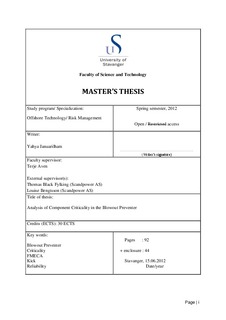| dc.description.abstract | During well drilling operation, there is a possibility of a kick (influx). When a kick is not controlled properly it will become a blow out. This is an uncontrolled and sudden flow of formation fluid that releases from a reservoir through a well bore into surface as a result of pressure difference in formation and well. The kick could flow to surface and create explosions causing fatality, environment damage and loss of asset resulting in high cost. There are procedures and methods to deal with the occurrence of kicks and blowouts in order to control a well flow. Moreover, well barriers should be established and designed based on the characteristics of the reservoir and rock formation. The last line of protection in well barriers is known as Blowout Preventer (BOP). It is one of the most important barriers to prevent unintentional hydrocarbon release when all well barriers in a well have failed. There are many factors that influence the performance of a BOP. The purpose of this thesis is to determine the criticality of components in BOP related to the redundancies they have during well shut in, stripping, snubbing and BOP testing operation. By knowing the criticality of BOP components, we can assure which components that should be focused on for maintenance and testing. It will also indicate which components that gives redundancy to the BOP during well shut in, stripping, snubbing and BOP testing operation, if one or more components are failed. A literature study is the main work of this thesis. Studying the principal, functions, operations and factors related to drilling activity with respect to the use of BOP. In addition, relevant regulations and standards are also describes to specify the required specification of BOP. The analysis of criticality is done by using risk tools such as reliability block diagram, FMECA, criticality matrix, redundancy and effect table. All of these risk tools complement each other to give the final conclusion of critical component in a BOP. The result of the analysis shows five critical components in a BOP with the prioritization start from shuttle valve (blind shear ram function), blind shear ram (ram piston), flange (BOP stack), gasket (BOP stack) and annular preventer (rubber housing) respectively. In the event of kick and well shut in is initiated, the above critical component is very critical to the safety of personnel. Stripping and snubbing operation also require the critical components to be function properly, but with less critical when well shut in has been done earlier. During BOP testing operation, the critical components might not be critical if it fail as there are many safety measure and procedure for safety. | no_NO |
